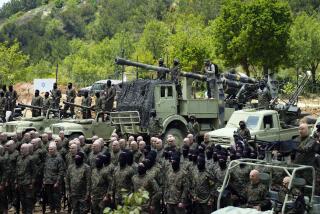Libya rebels seize Kadafi arms depot
- Share via
Reporting from Ghaaa military base, Libya — Nothing but a flimsy barbed wire fence surrounds a massive arsenal of ammunition and weapons stockpiled here in the desert by Libyan leader Moammar Kadafi.
No further fortifications were necessary. Until it was seized and pillaged by rebels Tuesday, local people were too terrified of Kadafi’s wrath to come anywhere near it.
“There was no need even for the barbed wire,” said Mostafa Mohammad, a scholar in Britain who returned to his hometown of Zintan, about 15 miles to the north, after the uprising against Kadafi’s rule began in February.
He was among hundreds of rebel fighters and onlookers from all parts of the opposition-held Nafusa mountain range visiting the military base after a quick battle that killed at least two opposition fighters and sent dozens of government soldiers fleeing.
Rebels were galvanized in part by the International Criminal Court’s decision Monday to issue arrest warrants for the Libyan leader, his son Seif Islam Kadafi and intelligence chief Abdullah Sanoussi.
In The Hague, court prosecutor Luis Moreno-Ocampo on Tuesday called on Kadafi’s aides to execute the arrest warrants.
“Kadafi cannot retain power to keep attacking his victims,” Moreno-Ocampo said. The prosecutor also said investigations were continuing into allegations that Kadafi loyalists raped civilian women and then tried to cover up the attacks.
While rebel fighters in eastern Libya and the pocket around the coastal city of Misurata are largely bogged down, those here in the predominantly ethnic Amazigh region have been waging an increasingly aggressive fight.
Rebels, who were equipped with small arms and high-caliber artillery guns mounted on pickup trucks, said they began approaching the site at midnight and then staged a double-pronged attack. One group of fighters was assigned to attack the base while the other cut off reinforcements.
The attack ended in less than half an hour, with about five dozen government soldiers fleeing to the nearby base at Twama. Some of the rebels began heading toward Twama, but appeared to be repelled by barrages of Grad and Katyusha rocket fire that shook the desert.
Some analysts on Arab television networks described the Ghaaa military base as the largest arms depot in Africa. Many of the weapons date back decades, some to 1972. But they were stored meticulously inside dozens of huge hangar-like concrete bunkers covered with dirt.
Many of them had already been struck in NATO bombing. But few were so badly damaged that enthusiastic rebels couldn’t gleefully salvage ammunition.
Though a lot of ammunition was stored at the site, there were few guns to fire it. Some said that was a result of Kadafi’s mistrust of even his closest aides.
“He’s got missile parts everywhere, but no full missiles and rockets anywhere,” said Dhaer Abdul Ali, a Ministry of Justice employee who has joined the rebels. “This makes it harder for us to use the weapons, but also harder for him to use them.”
Much of the Russian, Chinese, Italian and Spanish weaponry, including 1,000-pound bombs and Soviet-era Scud missiles, appeared to be gathering dust deep inside the bunkers. The munitions included several bunkers full of Russian 9M32M portable missiles dating as far back as 1982, which possibly could shoot down aircraft.
Rebels rummaged through bunker No. 12, which had been struck by a NATO bomb; it held Italian ignition fuses for incendiary weapons. In bunker No. 58 were sticks of dynamite, which rebels loaded onto pickup trucks. Down a narrow corridor was a huge supply of rockets and ammunition for high-caliber machine guns — but without the rocket launchers and guns.
In other bunkers, there were also parts for what appeared to be Russian and Italian cluster bombs, but it was not clear whether they were of the type allegedly used by Kadafi in civilian areas in Misurata.
The site lies miles from any paved road, accessible only via a treacherous network of desert roads.
As dusk settled after the fighting, long convoys of pickups and tractor-trailer trucks could be seen streaming back and forth across the desert to the site.
The insurgents also seized dozens of military vehicles. Some fighters said they had made three trips from their hometowns, filling up trucks and cars with munitions.
“Let’s go to Bab Aziziya,” said one rebel fighter, referring to Kadafi’s residential compound in Tripoli, the capital.
Times staff writer Henry Chu in London contributed to this report.
More to Read
Sign up for Essential California
The most important California stories and recommendations in your inbox every morning.
You may occasionally receive promotional content from the Los Angeles Times.













